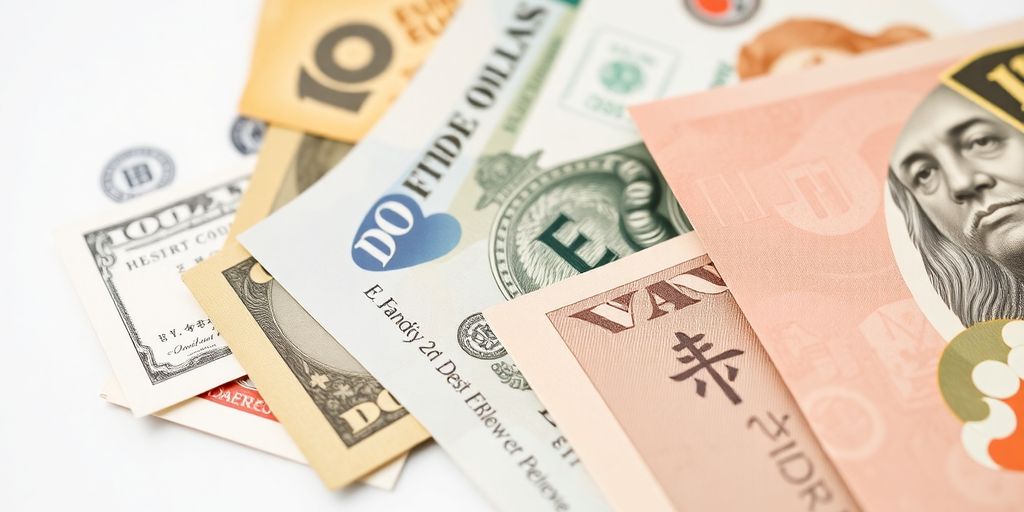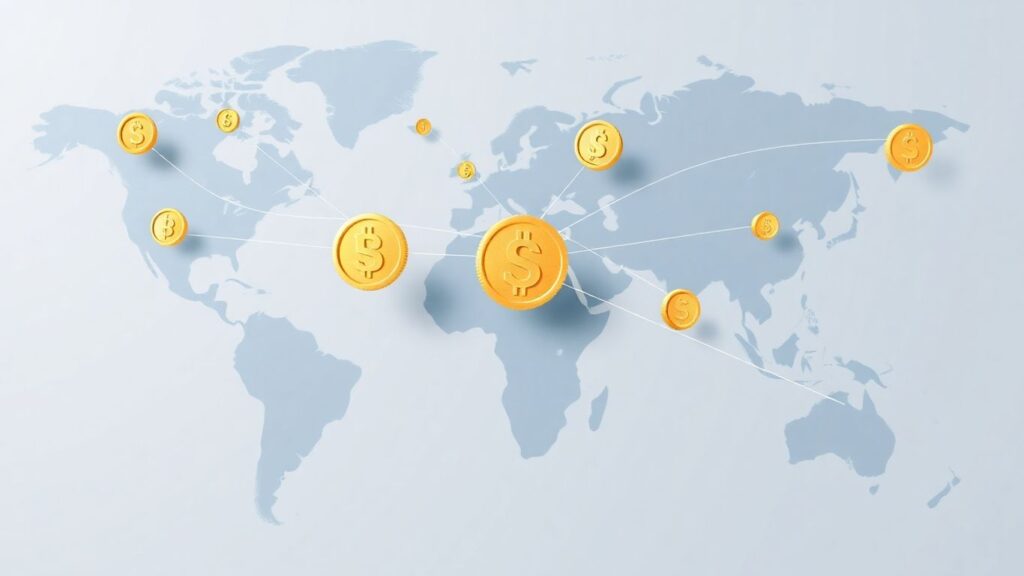The Future of Reserve Currency: Trends and Challenges in 2024

The world of reserve currencies is changing fast. As we step into 2024, there’s a lot to watch. The U.S. dollar has been the big boss for a long time, but things are stirring. New players are coming in, and technology is shaking things up. It’s like watching a game where the rules are changing as you play. So, what does this mean for the future of money? Let’s break it down.
Key Takeaways
- The U.S. dollar’s dominance is being challenged by emerging market currencies and geopolitical shifts.
- Digital currencies, including cryptocurrencies, are starting to influence global reserve currency dynamics.
- Central banks are rethinking their strategies, with some diversifying away from the dollar.
- Technology, like blockchain, is playing a bigger role in how currencies are managed and exchanged.
- Future scenarios might see a multipolar currency system, reducing reliance on any single currency.
The Evolution of Global Reserve Currencies
Historical Context and Development
Once upon a time, gold was king. Back in the 19th century, the gold standard ruled the roost. The British pound was the big cheese, but it wasn’t alone. The French franc also had a piece of the pie. Fast forward to the mid-20th century, and the U.S. dollar took the crown. Post-World War II, the dollar became the go-to currency for central banks. It was a unique time when one currency dominated so heavily. This period was an exception rather than the rule in the history of global finance.
Key Players in the Reserve Currency Market
Today, the dollar still holds a hefty chunk of the market, but it’s not the only player in town. The euro, yen, and pound are part of the "big four," though they haven’t gained much ground recently. Meanwhile, nontraditional currencies like the Australian dollar, Canadian dollar, and Chinese renminbi are making waves. They’re gaining traction thanks to their diversification benefits and attractive yields.
Impact of Economic Shifts on Reserve Currencies
Economic shifts are shaking up the reserve currency scene. The U.S. dollar’s dominance is being challenged, not only by traditional currencies but also by emerging market players. With new digital financial technologies, these currencies are easier to trade and hold. Plus, geopolitical factors are nudging countries to diversify their reserves. While the dollar remains on top, the landscape is slowly changing, hinting at a future where multiple currencies might share the spotlight.
Current Trends in Reserve Currency Dynamics
Rise of Emerging Market Currencies
The global reserve currency landscape is shifting, with emerging market currencies gaining ground. The Chinese renminbi, for example, is making waves in the market. Despite some recent setbacks, like the depreciation of its exchange rate, the renminbi is still a hot topic. Other nontraditional currencies like the Australian and Canadian dollars are also seeing increased interest. This trend is driven by countries looking to diversify their reserves and seek better yields. Some nations are even moving away from the U.S. dollar due to geopolitical reasons.
Digital Currencies and Their Influence
Digital currencies are changing the game. Central banks around the world are exploring digital versions of their national currencies. This is partly in response to the rise of cryptocurrencies and the need for more efficient cross-border transactions. Digital currencies could potentially alter the reserve currency dynamics by offering a new form of liquidity and convenience. The development of digital payment systems and blockchain technology is paving the way for these changes.
Shifts in Central Bank Policies
Central banks are reevaluating their policies in response to these currency shifts. With the advent of digital currencies and the rise of emerging market currencies, central banks are adapting their strategies. Interest rate changes and monetary policy adjustments are becoming more frequent as banks try to manage inflation and economic growth. The nominal trade-weighted dollar has appreciated recently, influenced by these global currency movements. This appreciation reflects the complex interplay of various economic factors that central banks must navigate.
Challenges Facing the Dominance of the U.S. Dollar
Geopolitical Tensions and Their Effects
Geopolitical tensions have a way of shaking things up, and the U.S. dollar isn’t immune. The dollar’s dominance is increasingly questioned as global power dynamics shift. Countries are forming new alliances and trading blocs, often as a response to geopolitical events like the Russia-Ukraine conflict. These shifts can lead to changes in currency preferences for international trade and reserves. As nations like China push for their own currencies to take a larger role in global transactions, the dollar’s stronghold is challenged.
Economic Policies and Inflation Concerns
Economic policies in the U.S. can have ripple effects on the dollar’s status. With ongoing debates about fiscal policy, government spending, and inflation, there’s a lot at stake. Inflation, in particular, can erode the dollar’s purchasing power, making it less attractive as a reserve currency. Central banks around the world keep a close eye on U.S. economic policy, as any instability could prompt them to diversify their reserves into other currencies.
Competition from Other Currencies
The dollar has long been the king, but other currencies are vying for a piece of the pie. The euro and the Chinese renminbi are often mentioned as potential challengers. However, it’s not just the big players; smaller currencies are also gaining traction. Countries are exploring alternatives to reduce dependency on the dollar, especially with advancements in digital payment systems and the increasing use of national currencies in trade agreements. This trend towards diversification is gradual but significant, as it could lead to a decrease in the dollar’s dominance in global currency reserves over the coming decades.
The world is slowly moving towards a more diversified currency system. While the U.S. dollar remains a dominant force, the landscape is evolving, with countries seeking to balance their economic and strategic interests through varied currency holdings.
The Role of Technology in Shaping Future Currencies
Blockchain and Cryptocurrency Innovations
Blockchain technology is not just about cryptocurrencies anymore. It’s reshaping how we think about money and transactions. By offering a decentralized and transparent ledger system, blockchain is opening doors to new forms of currency and payment systems. Central banks are exploring digital currencies (CBDCs) that leverage blockchain for more secure and efficient transactions. This shift could potentially change the way we handle money on a global scale.
Fintech’s Impact on Currency Exchange
Fintech companies are revolutionizing currency exchange by making it more accessible and cost-effective. Traditional banks are facing competition from these nimble startups that offer faster and cheaper services. Here are some ways fintech is changing the landscape:
- Real-time currency exchange platforms that eliminate delays.
- Lower transaction fees compared to traditional financial institutions.
- Enhanced user experience with intuitive interfaces and mobile access.
Cybersecurity in Digital Transactions
As digital currencies become more prevalent, the need for robust cybersecurity measures is critical. The risk of cyber-attacks on digital transactions is a major concern. To protect users, financial institutions are investing in advanced security technologies such as biometric authentication and AI-driven threat detection. Ensuring the safety of digital transactions is paramount to gaining public trust and promoting wider adoption of digital currencies.
The integration of technology in financial systems is not just a trend; it’s a transformation. As we move towards a digital economy, technology will continue to play a pivotal role in shaping the future of currencies.
Potential Scenarios for the Future of Reserve Currencies

Multipolar Currency System Possibilities
Imagine a world where no single currency dominates. This is the idea behind a multipolar currency system. Historically, the U.S. dollar has been the king, but things are shifting. Some experts say that a multipolar world is on the horizon, where different currencies share the stage. The euro and the Chinese renminbi are often mentioned as potential contenders, but they face their own challenges. For instance, the euro has political hurdles, while the renminbi struggles with market transparency. Still, the idea of a more balanced currency landscape is gaining traction.
Impact of Global Trade Agreements
Trade agreements play a huge role in shaping currency dynamics. These agreements can boost a currency’s international status by increasing its use in global transactions. For example, if a major trade deal favors the euro or renminbi, it could enhance their roles as reserve currencies. However, political tensions and economic policies can complicate these outcomes. Countries need to carefully navigate these agreements to ensure they benefit their currencies’ standing on the global stage.
Future Economic Predictions and Models
Predicting future economic trends is tricky, but it’s important for understanding reserve currency dynamics. Economists use models to forecast how currencies might perform based on various factors like inflation, growth rates, and geopolitical events. For instance, as inflation decreases and central banks become more accommodating, growth could become a key driver in currency trends. These predictions help countries and investors make informed decisions about which currencies to hold or invest in, shaping the future of global reserves.
The future of reserve currencies is not set in stone. It’s a dynamic landscape influenced by economic shifts, technological advancements, and geopolitical changes. As the world becomes more interconnected, the balance of power among currencies might look very different in the years to come.
Policy Implications for Global Economies

Regulatory Challenges and Opportunities
As the global economy becomes more intertwined, regulatory frameworks need to keep pace with rapid changes. The shift towards digital currencies and innovative financial technologies presents both hurdles and openings for regulators. Policymakers must balance fostering innovation with ensuring financial stability. This involves:
- Developing international standards for digital currencies to prevent regulatory arbitrage.
- Ensuring robust data protection and privacy measures.
- Encouraging cross-border cooperation to address global financial risks.
Monetary Policy Adjustments
Central banks are under pressure to adapt their monetary policies in response to evolving global dynamics. This includes managing inflationary pressures and adjusting interest rates to stabilize economies. The following are key considerations:
- Monitoring the impact of emerging market currencies on global trade.
- Evaluating the role of central bank digital currencies in monetary policy.
- Addressing the challenges posed by geopolitical tensions on currency stability.
International Cooperation and Agreements
In an increasingly interconnected world, international cooperation is crucial to address global economic challenges. Agreements on trade, technology, and finance can help mitigate risks and enhance economic resilience. Key areas for collaboration include:
- Harmonizing tax policies to prevent base erosion and profit shifting.
- Coordinating efforts to combat financial crime and money laundering.
- Sharing best practices for sustainable economic development.
Policymakers worldwide must navigate a complex landscape of economic and technological changes. The ability to adapt and collaborate will determine the success of global economies in the coming years.
In this context, a policy pivot is necessary to address economic challenges and maintain sustainable debt dynamics. As monetary policies evolve, fiscal strategies must be adjusted to ensure long-term economic stability.
Conclusion
As we look ahead to 2024, the landscape of global reserve currencies is poised for change, yet remains anchored by the enduring presence of the U.S. dollar. While the dollar’s dominance faces potential challenges from emerging currencies like the euro and renminbi, these contenders still grapple with hurdles that limit their immediate impact. The euro struggles with liquidity issues, and the renminbi is constrained by China’s closed financial markets and political factors. Meanwhile, geopolitical tensions and economic shifts continue to influence the dynamics of reserve currency preferences. Despite these challenges, the dollar’s role as the primary reserve currency appears secure for now, supported by its deep-rooted financial infrastructure and widespread acceptance. However, the gradual diversification of reserves and the rise of nontraditional currencies suggest that the global financial system is slowly evolving. This evolution may not lead to a dramatic shift overnight, but it signals a future where multiple currencies could share the stage, reflecting a more multipolar world economy.
Frequently Asked Questions
What is a reserve currency?
A reserve currency is money that countries keep in large amounts to help with international trade and finance. It’s like having a backup currency that everyone trusts.
Why is the U.S. dollar so important?
The U.S. dollar is important because many countries use it for buying and selling goods around the world. It’s trusted and accepted almost everywhere.
Can other currencies become reserve currencies?
Yes, other currencies like the euro or China’s renminbi can become reserve currencies if more countries start using them for trade and saving.
How do digital currencies affect reserve currencies?
Digital currencies, like Bitcoin, can change how people use money, but they are not yet stable enough to replace traditional reserve currencies.
What challenges does the U.S. dollar face?
The U.S. dollar faces challenges like political tensions, inflation, and competition from other currencies that might weaken its dominance.
What role does technology play in currency exchange?
Technology helps make currency exchange faster and safer with things like blockchain and online banking, but it also needs strong security to protect against cyber threats.








Responses